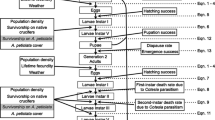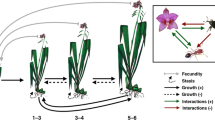Abstract
Resident natural enemies can impact invasive species by causing Allee effects, leading to a reduction in establishment success of small founder populations, or by regulating or merely suppressing the abundance of established populations. Epiphyas postvittana, the Light Brown Apple Moth, an invasive leafroller in California, has been found to be attacked by a large assemblage of resident parasitoids that cause relatively high rates of parasitism. Over a 4-year period, we measured the abundance and per capita growth rates of four E. postvittana populations in California and determined parasitism rates. We found that at two of the sites, parasitism caused a component Allee effect, a reduction in individual survivorship at lower E. postvittana population densities, although it did not translate into a demographic Allee effect, an impact on per capita population growth rates at low densities. Instead, E. postvittana populations at all four sites exhibited strong compensatory density feedback throughout the entire range of densities observed at each site. As we found no evidence for a negative relationship between per capita population growth rates and parasitism rates, we concluded that resident parasitoids were unable to regulate E. postvittana populations in California. Despite a lack of evidence for regulation or a demographic Allee effect, the impact of resident parasitoids on E. postvittana populations is substantial and demonstrates significant biotic resistance against this new invader.




Similar content being viewed by others
References
Abbott KC, Morris WF, Gross K (2008) Simultaneous effects of food limitation and inducible resistance on herbivore population dynamics. Theor Popul Biol 73:63–78
Allee WC (1931) Animal aggregations: a study in general sociology. University of Chicago Press, Chicago
Angulo E, Roemer GW, Berec L, Gascoigne J, Courchamp F (2007) Double Allee effects and extinction in the island fox. Conserv Biol 21:1082–1091
Bartlett AC, Wolf WW (1985) Pectinophora gossypiella. In: Moore RF, Singh P (eds) Handbook of Insect Rearing. Elsevier Scientific Publishing Company, Amsterdam, pp 415–430
Berryman AA (2002) Population cycles: the case of trophic interactions. Oxford University Press, New York
Brockerhoff EG, Suckling DM, Ecroyd CE, Wagstaff SJ, Raabe MC, Dowell RV, Wearing CH (2011) Worldwide host plants of the highly polyphagous, invasive Epiphyas postvittana (Lepidoptera: Tortricidae). J Econ Entomol 104:1514–1524
Bürgi LP, Mills NJ (2014) Lack of enemy release for an invasive leafroller in California: temporal patterns and influence of host plant origin. Biol Invasions 16:1021–1034
Bürgi LP, Roltsch WJ, Mills NJ (2011) Abundance, age structure, and voltinism of light brown apple moth populations in California. Environ Entomol 40:1370–1377
Carlsson NOL, Bustamante H, Strayer DL, Pace ML (2011) Biotic resistance on the increase: native predators structure invasive zebra mussel populations. Freshwater Biol 56:1630–1637
Catford JA, Jansson R, Nilsson C (2009) Reducing redundancy in invasion ecology by integrating hypotheses into a single theoretical framework. Divers Distrib 15:22–40
Colautti RI, Ricciardi A, Grigorovich IA, MacIsaac HJ (2004) Is invasion success explained by the enemy release hypothesis? Ecol Lett 7:721–733
Courchamp F, Berec L, Gascoigne J (2008) Allee effects in ecology and conservation. Oxford University Press, New York
Cunningham N (2007) Lightbrown apple moth (LBAM) culture Epiphyas postvittana. South Australian Research and Development Institute (S.A.R.D.I.), Australia
Danthanarayana W (1975) The bionomics, distribution and host range of the light brown apple moth, Epiphyas postvittana (Walk.) (Tortricidae). Aust J Zool 23:419–437
Danthanarayana W (1983) Population ecology of the light brown apple moth, Epiphyas postvittana (Lepidoptera: Tortricidae). J Anim Ecol 52:1–33
Davis MA (2009) Invasion biology. Oxford University Press, New York
Development Core Team R (2012) R: A language and environment for statistical computing. R Foundation for Statistical Computing, Vienna
Drake JM, Lodge DM (2006) Allee effects, propagule pressure and the probability of establishment: risk analysis for biological invasions. Biol Invasions 8:365–375
Dumont C, Gaymer C, Thiel M (2011) Predation contributes to invasion resistance of benthic communities against the non-indigenous tunicate Ciona intestinalis. Biol Invasions 13:2023–2034
Edelstein-Keshet L, Rausher MD (1989) The effects of inducible plant defenses on herbivore populations. 1. Mobile herbivores in continuous time. Am Nat 133:787–810
Elton CS (1958) The ecology of invasions. Methuen, London
Gascoigne JC, Lipcius RN (2004) Allee effects driven by predation. J Appl Ecol 41:801–810
Geier PW, Briese DT (1980) The light-brown apple moth, Epiphyas postvittana (Walker): 4. Studies on population dynamics and injuriousness to apples in the Australian Capital Territory. Austral Ecol 5:63–93
Gilligan TM, Epstein D (2009) LBAM ID: Tools for diagnosing light brown apple moth and related western U.S. leafrollers (Tortricidae: Archipini) [CD-ROM]. Center for Plant Health Science and Technology. USDA APHIS PPQ, Raleigh, NC
Gutierrez AP, Mills NJ, Ponti L (2010) Limits to the potential distribution of light brown apple moth in Arizona-California based on climate suitability and host plant availability. Biol Invasions 12:3319–3331
Halpern SL, Underwood N (2006) Approaches for testing herbivore effects on plant population dynamics. J Appl Ecol 43:922–929
Hassell MP (2000) The spatial and temporal dynamics of host-parasitoid interactions. Oxford University Press, Oxford
Herrando-Pérez S, Delean S, Brook BW, Bradshaw CJA (2012a) Density dependence: an ecological Tower of Babel. Oecologia 170:585–603
Herrando-Pérez S, Delean S, Brook BW, Bradshaw CJA (2012b) Decoupling of component and ensemble density feedbacks in birds and mammals. Ecology 93:1728–1740
Hogg BN, Wang X-G, Levy K, Mills NJ, Daane KM (2013) Complementary effects of resident natural enemies on the suppression of the introduced moth Epiphyas postvittana. Biol Control 64:125–131
Kaplan I, Denno RF (2007) Interspecific interactions in phytophagous insects revisited: a quantitative assessment of competition theory. Ecol Lett 10:977–994
Karban R, Baldwin IT (1997) Induced responses to herbivory. University of Chicago Press, Chicago
Kessler A, Poveda K, Poelman EH (2012) Plant-induced responses and herbivore population dynamics. In: Barbosa P, Letourneau DK, Agrawal AA (eds) Insect outbreaks revisited. Blackwell Publishing Ltd., West Sussex, pp 89–112
Kramer AM, Drake JM (2010) Experimental demonstration of population extinction due to a predator-driven Allee effect. J Anim Ecol 79:633–639
Kramer AM, Dennis B, Liebhold AM, Drake JM (2009) The evidence for Allee effects. Popul Ecol 51:341–354
Levine JM, Adler PB, Yelenik SG (2004) A meta-analysis of biotic resistance to exotic plant invasions. Ecol Lett 7:975–989
Lewis MA, Kareiva P (1993) Allee dynamics and the spread of invading organisms. Theor Popul Biol 43:141–158
Liebhold A, Bascompte J (2003) The Allee effect, stochastic dynamics and the eradication of alien species. Ecol Lett 6:133–140
Liebhold AM, Tobin PC (2008) Population ecology of insect invasions and their management. Annu Rev Entomol 53:387–408
Liu H, Stiling P (2006) Testing the enemy release hypothesis: a review and meta-analysis. Biol Invasions 8:1535–1545
Mack RN, Simberloff D, Lonsdale WM, Evans H, Clout M, Bazzaz FA (2000) Biotic invasions: causes, epidemiology, global consequences, and control. Ecol Appl 10:689–710
Maron JL, Vilà M (2001) When do herbivores affect plant invasion? Evidence for the natural enemies and biotic resistance hypotheses. Oikos 95:361–373
McEvoy PB, Coombs EM (1999) Biological control of plant invaders: regional patterns, field experiments, and structured population models. Ecol Appl 9:387–401
Mills NJ (1994) Parasitoid guilds: defining the structure of the parasitoid communities of endopterygote insect hosts. Environ Entomol 23:1066–1083
Mills NJ (2005) Selecting effective parasitoids for biological control introductions: codling moth as a case study. Biol Control 34:274–282
Mitchell CE, Power AG (2003) Release of invasive plants from fungal and viral pathogens. Nature 421:625–627
Murdoch WW, Briggs CJ, Nisbet RM (2003) Consumer-resource dynamics. Princeton University Press, Princeton
Pyšek P, Richardson DM (2006) The biogeography of naturalization in alien plants. J Biogeogr 33:2040–2050
Raghu S, Wilson JR, Dhileepan K (2006) Refining the process of agent selection through understanding plant demography and plant response to herbivory. Aust J Entomol 45:308–316
Ricciardi A (2007) Are modern biological invasions an unprecedented form of global change? Conserv Biol 21:329–336
Ricciardi A, Cohen J (2007) The invasiveness of an introduced species does not predict its impact. Biol Invasions 9:309–315
Rohde K (2006) Nonequilibrium ecology. Cambridge University Press, New York
Roltsch W, Carruthers N, Stouthamer R, Saechao N (2010) Parasitism and predation of light brown apple moth eggs. In: Woods DM (ed) Biological control program 2009 annual summary. California Department of Food and Agriculture, Plant Health and Pest Prevention Services, CA, pp 9–11
Roltsch W, Carruthers N, Stouthammer R (2011) Field parasitism and predation of light brown apple moth eggs. In: Woods DM (ed) Biological control program 2010 annual summary. California Department of Food and Agriculture, Plant Health and Pest Prevention Services, CA, pp 30–32
Rotem KA, Agrawal AA (2003) Density dependent population growth of the two-spotted spider mite, Tetranychus urticae, on the host plant Leonurus cardiaca. Oikos 103:559–565
Sarfraz RM, Cory JS, Myers JH (2013) Life-history consequences and disease resistance of western tent caterpillars in response to localised, herbivore-induced changes in alder leaf quality. Ecol Entomol 38:61–67
Schmickl T, Karsai I (2010) The interplay of sex ratio, male success and density-independent mortality affects population dynamics. Ecol Model 221:1089–1097
Schutzenhofer MR, Valone TJ, Knight TM (2009) Herbivory and population dynamics of invasive and native Lespedeza. Oecologia 161:57–66
Seitz RD, Lipcius RN, Hines AH, Eggleston DB (2001) Density-dependent predation, habitat variation, and the persistence of marine bivalve prey. Ecology 82:2435–2451
Simberloff D (2009) The role of propagule pressure in biological invasions. Annu Rev Ecol Evol Syst 40:81–102
Snell TW, Dingmann BJ, Serra M (2001) Density-dependent regulation of natural and laboratory rotifer populations. Hydrobiologia 446/447:39–44
Stephens PA, Sutherland WJ, Freckleton RP (1999) What Is the Allee effect? Oikos 87:185–190
Symondson WOC, Glen DM, Ives AR, Langson CJ, Wiltshire CW (2002) Dynamics of the relationship between a generalist predator and slugs over five years. Ecology 83:137–147
Taylor CM, Hastings A (2005) Allee effects in biological invasions. Ecol Lett 8:895–908
Tobin PC, Berec L, Liebhold AM (2011) Exploiting Allee effects for managing biological invasions. Ecol Lett 14:615–624
Torchin ME, Lafferty KD, Dobson AP, McKenzie VJ, Kuris AM (2003) Introduced species and their missing parasites. Nature 421:628–630
Underwood N (1999) The influence of plant and herbivore characteristics on the interaction between induced resistance and herbivore population dynamics. Am Nat 153:282–294
Underwood N (2000) Density dependence in induced plant resistance to herbivore damage: threshold, strength and genetic variation. Oikos 89:295–300
Underwood N (2010) Density dependence in insect performance within individual plants: induced resistance to Spodoptera exigua in tomato. Oikos 119:1993–1999
Underwood N, Rausher M (2002) Comparing the consequences of induced and constitutive plant resistance for herbivore population dynamics. Am Nat 160:20–30
USDA-APHIS (2012) Light brown apple moth, program situation reports. http://www.aphis.usda.gov/plant_health/plant_pest_info/lba_moth/index.shtml
Wang X-G, Levy K, Mills NJ, Daane KM (2012) Light brown apple moth in California: a diversity of host plants and indigenous parasitoids. Environ Entomol 41:81–90
Acknowledgments
This research was supported by funding from USDA-APHIS and the California Department of Food and Agriculture. We thank numerous taxonomists that helped identify the parasitoids, including John Luhman (University of Minnesota), James O’Hara (Invertebrate Biodiversity, Agriculture and Agri-Food Canada), and John Heraty (UC Riverside). We also thank Wayne Sousa for his helpful comments on an earlier version of this manuscript.
Author information
Authors and Affiliations
Corresponding author
Rights and permissions
About this article
Cite this article
Bürgi, L.P., Roltsch, W.J. & Mills, N.J. Allee effects and population regulation: a test for biotic resistance against an invasive leafroller by resident parasitoids. Popul Ecol 57, 215–225 (2015). https://doi.org/10.1007/s10144-014-0451-4
Received:
Accepted:
Published:
Issue Date:
DOI: https://doi.org/10.1007/s10144-014-0451-4




